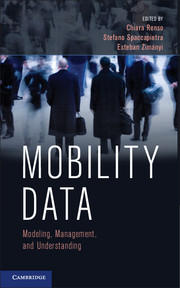Book contents
- Frontmatter
- Contents
- List of Contributors
- Preface
- Acknowledgments
- PART I MOBILITY DATA MODELING AND REPRESENTATION
- PART II MOBILITY DATA UNDERSTANDING
- PART III MOBILITY APPLICATIONS
- 10 Car Traffic Monitoring
- 11 Maritime Monitoring
- 12 Air Traffic Analysis
- 13 Animal Movement
- 14 Person Monitoring with Bluetooth Tracking
- PART IV FUTURE CHALLENGES AND CONCLUSIONS
- Bibliography
- Glossary
- Author Index
- Subject Index
- Plate section
14 - Person Monitoring with Bluetooth Tracking
from PART III - MOBILITY APPLICATIONS
Published online by Cambridge University Press: 05 October 2013
- Frontmatter
- Contents
- List of Contributors
- Preface
- Acknowledgments
- PART I MOBILITY DATA MODELING AND REPRESENTATION
- PART II MOBILITY DATA UNDERSTANDING
- PART III MOBILITY APPLICATIONS
- 10 Car Traffic Monitoring
- 11 Maritime Monitoring
- 12 Air Traffic Analysis
- 13 Animal Movement
- 14 Person Monitoring with Bluetooth Tracking
- PART IV FUTURE CHALLENGES AND CONCLUSIONS
- Bibliography
- Glossary
- Author Index
- Subject Index
- Plate section
Summary
The Difficult Nature of Measuring Human Mobility
Human mobility on different spatial and temporal scales affects many processes taking place in our world. Although few will disagree that the large increase in human mobility during the twenty-first century has improved our general quality of life, it is increasingly confronting us with some of its more negative implications as well: congestion in and around densely populated areas by daily commuter traffic and the resulting strain on our environment, safety issues arising from the gathering of large crowds in relatively small areas, sudden risks of global pandemics and the difficulty of containing them, and so on. As such, an increase in human mobility should be accompanied by a deeper understanding of the processes governing these movements in order to better mitigate their negative implications.
A starting point in learning more about these movements is adequately measuring them. Until recently, this has been quite problematic. Qualitative methods such as shadowing and the collection of travel diaries are known to be error prone and labor intensive. An alternative method of tracking people in smaller-scale settings is through video surveillance systems. Despite technological advancements in the last decade, using cameras to reconstruct the movements of a large number of people in a realistic environment remains very difficult. Correctly identifying trajectories of individuals in one camera view is already nontrivial due to interactions between moving objects, changing illumination in outdoor environments, and so on.
- Type
- Chapter
- Information
- Mobility DataModeling, Management, and Understanding, pp. 277 - 294Publisher: Cambridge University PressPrint publication year: 2013
- 1
- Cited by



